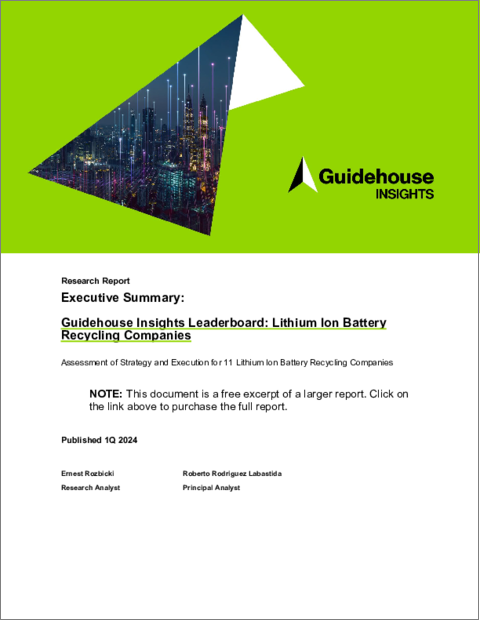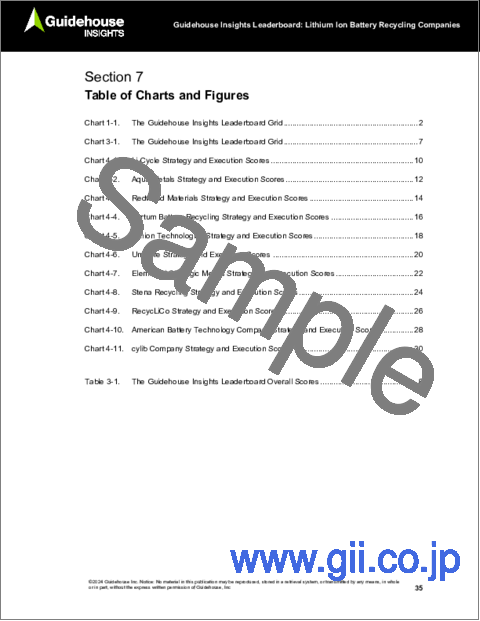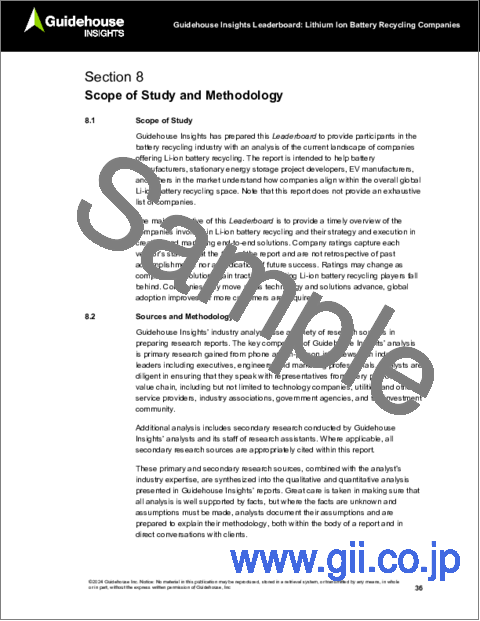|
|
市場調査レポート
商品コード
1415553
Guidehouse Insights Leaderboard Report - リチウムイオン電池リサイクル企業:リチウムイオン電池リサイクル企業11社の戦略と実行力の評価Guidehouse Insights Leaderboard Report - Lithium Ion Battery Recycling Companies: Assessment of Strategy and Execution for 11 Lithium Ion Battery Recycling Companies |
||||||
| Guidehouse Insights Leaderboard Report - リチウムイオン電池リサイクル企業:リチウムイオン電池リサイクル企業11社の戦略と実行力の評価 |
|
出版日: 2024年01月24日
発行: Guidehouse Insights
ページ情報: 英文 39 Pages; 17 Tables, Charts & Figures
納期: 即納可能
|
- 全表示
- 概要
- 図表
- 目次
リチウムイオン (Li-ion) 電池は、電動モビリティや据置型エネルギー貯蔵の市場を独占しています。EVの市場シェアが拡大し、年中無休の自然エネルギーへのシフトが進む中、使用済み電池のソリューションに関する疑問が浮上しています。一部の電池、特に使用済みのEV用電池は、他の用途に再利用可能です。リチウムイオン電池のリサイクルは、循環型経済と重要鉱物の自立を達成する上で極めて重要です。現在、リチウム精製とリチウムイオン電池の生産は中国が独占しています。こうした生産の不均衡は、持続可能なエネルギーシステムへの移行を確実なものにするために不可欠なサプライチェーン全体が管理できなくなるため、北米と欧州を不利な立場に追いやっています。さらに、リチウムイオン電池の原材料の供給は限られており、世界でも数カ国に集中しています。
電池のリサイクルはこの問題へのソリューションを提供しており、北米と欧州は、すでに国内市場に供給された電池に使用されている重要な材料を維持することができます。10年後までには、第一世代のEVや据置型電池の多くが寿命を迎えるため、リサイクル企業はこのような大量の原料の流入に対応する準備が必要になります。
当レポートでは、世界のリチウムイオン電池リサイクル市場の主要企業11社について、現在のリサイクル能力や市場でのポジション、今後の事業拡張計画といった指標に基いて評価しております。
目次
第1章 エグゼクティブサマリー
第2章 市場概要
- 市場の定義
- 市場促進要因
- 市場の障壁
- 市場動向
第3章 Guidehouse Insights Leaderboard
- Guidehouse Insights Leaderboardのカテゴリ
- リーダー
- コンテンダー
- チャレンジャー
- フォロワー
- Guidehouse Insights Leaderboardのグリッド
第4章 企業ランキング
- リーダー
- Li-Cycle
- Aqua Metals
- Redwood Materials
- コンテンダー
- Fortum Battery Recycling
- Lithion Technologies
- Umicore
- Elemental Strategic Metals
- Stena Recycling
- RecycLiCo
- American Battery Technology Company
- cylib
第5章 頭字語・略語の一覧
第6章 目次
第7章 図表
第8章 調査範囲・手法
- 調査範囲
- 情報源と調査手法
- ベンダーの選択
- 評価スケール
- 基準の定義
List of Tables
The Guidehouse Insights Leaderboard Overall Scores
Vendor Scores
Vendor Scores on Strategy Criteria
Vendor Scores on Execution Criteria
List of Figures
The Guidehouse Insights Leaderboard Grid
Li-Cycle Strategy and Execution Scores
Aqua Metals Strategy and Execution Scores
Redwood Materials Strategy and Execution Scores
Fortum Battery Recycling Strategy and Execution Scores
Lithion Technologies Strategy and Execution Scores
Umicore Strategy and Execution Scores
Elemental Strategic Metals Strategy and Execution Scores
Stena Recycling Strategy and Execution Scores
RecycLiCo Strategy and Execution Scores
American Battery Technology Company Strategy and Execution Scores
cylib Company Strategy and Execution Scores
Company Strategy and Execution Scores
Lithium ion (Li-ion) batteries dominate the electromobility and stationary energy storage markets. With EVs' growing market share and the shift to 24/7 renewables, questions about end-of-life battery solutions arise. While some batteries can be reused for other applications-particularly used EV batteries-Li-ion battery recycling will be crucial in achieving a circular economy and critical minerals independence. Currently, China dominates lithium refining as well as Li-ion battery production. This imbalance of production puts North America and Europe at a disadvantage, as they do not control the whole supply chain, which is crucial to securing the transition to sustainable energy systems. Furthermore, the supply of raw materials for Li-ion batteries is limited and concentrated in a few countries across the globe.
Battery recycling offers a solution to this problem, allowing North America and Europe to keep the critical materials used in the batteries that already entered the local market. By the end of the decade, many first-generation EVs and stationary batteries will reach their end of life, so recycling companies will need to be prepared to handle such a large influx of feedstock.
This Guidehouse Insights Leaderboard assesses the major Li-ion battery recyclers, including their current recycling capabilities, market position, and expansion plans. Most companies are still in the pilot stages of their technologies, and although the market size is relatively small, many players are trying to establish themselves as the go-to provider, to capture as much of the market as possible before it booms at the end of the decade. Both legacy recyclers (companies with experience recycling precious metals and scrap) as well as newcomers (companies dedicated to Li-ion battery recycling) are active in the space.
Table of Contents
1. Executive Summary
- 1.1 Market Introduction
- 1.2 The Guidehouse Insights Leaderboard Grid
2. Market Overview
- 2.1 Market Definition
- 2.2 Market Drivers
- 2.3 Market Barriers
- 2.4 Market Trends
3. The Guidehouse Insights Leaderboard
- 3.1 The Guidehouse Insights Leaderboard Categories
- 3.1.1 Leaders
- 3.1.2 Contenders
- 3.1.3 Challengers
- 3.1.4 Followers
- 3.2 The Guidehouse Insights Leaderboard Grid
4. Company Rankings
- 4.1 Leaders
- 4.1.1 Li-Cycle
- 4.1.2 Aqua Metals
- 4.1.3 Redwood Materials
- 4.2 Contenders
- 4.2.1 Fortum Battery Recycling
- 4.2.2 Lithion Technologies
- 4.2.3 Umicore
- 4.2.4 Elemental Strategic Metals
- 4.2.5 Stena Recycling
- 4.2.6 RecycLiCo
- 4.2.7 American Battery Technology Company
- 4.2.8 cylib
5. Acronym and Abbreviation List
6. Table of Contents
7. Table of Charts and Figures
8. Scope of Study and Methodology
- 8.1 Scope of Study
- 8.2 Sources and Methodology
- 8.2.1 Vendor Selection
- 8.2.2 Ratings Scale
- 8.2.2.1 Score Calculations
- 8.2.3 Criteria Definitions
- 8.2.3.1 Strategy
- 8.2.3.2 Execution




